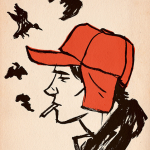If you haven’t yet read Where’d You Go, Bernadette by Maria Semple (Little, Brown and Company 2012; out in paperback this month) it will likely be your favorite beach read this summer, so I won’t give away the ending. It’s the beautiful and hilarious story of 15 year old Bee Branch’s attempt to understand what happened when her mother disappeared without warning on the day before they were set to leave for an Antarctic vacation.
A modern epistolary novel, the book is Bee’s organization of the paper trail her mother left behind. Though in places we read Bee’s narration, most of the novel consists of documents – emails, letters, faxes, report cards, and websites. Bee is precocious (that report card contains perfect grades), but strong and sweet, a nice counterpoint to her slightly unhinged mother Bernadette. Once upon a time, Bernadette Fox was an architect in Los Angeles, working with green design before green design was a thing. She won a MacArthur “genius” grant, but through a series of circumstances lost the house she’d been working on and moved to Seattle with her husband Elgie, a top executive at Microsoft famous for giving the 4th most-watched-of-all-time TED talk.
Bernadette has strong relationships with her husband and daughter at the book’s beginning, but not with anybody else (except a virtual personal assistant from India whom she pays seventy-five cents per hour to order her take-out and make her doctor’s appointments). Misanthropic, agoraphobic, and creatively stuck, Bernadette rarely leaves her home, and her rants about how awful Seattle culture is are among the funniest parts of the book.
Though Semple rakishly but lovingly lampoons all manner of things in this novel – from Seattle’s fashion to private school fundraisers to helicopter parents to the Canadian temperament – she mostly lets religion off the hook, treating it almost tenderly. Her reverence for religion is surprising not only because Semple herself is “in no way a religious person” but also because so many modern American novels – think Jonathan Franzen’s Freedom or Jenifer Egan’s Visit With the Goon Squad – tell stories with hardly a single reference to God. Though Where’d You Go, Bernadette is set in what is often labelled one of the most “unchurched” cities in America, the characters regularly refer to God as an active presence in their lives.
There are three notable points in the story where God shows up. First, when Bee is born with a heart defect, Bernadette makes a bargain with God. She explains:
Elgie once gave me a locket of Saint Bernadette, who had eighteen visions. He said Beeber Bifocal and Twenty Mile {houses} were my first two visions. I dropped to my knees at Bee’s incubator and grabbed my locket. “I will never build again,” I said to God. “I will renounce my other sixteen visions if you’ll keep my baby alive.” It worked.
Though religion hasn’t played a continuing role in Bernadette’s life, her daughter Bee regularly attends a Youth Group. Bee explains that she’s not a “Jesus freak,” but that she likes the Youth Group leaders and is happy to have something to do on Friday nights. At the Radio City Christmas Spectacular with the Youth Group, though, Bee has a religious experience that leaves her in tears during a performance of “O Holy Night.”
Something about the tune made me close my eyes. The words and music filled me with a warm glow…The glow inside me started to harden, which made it difficult to swallow…It was so weird and extreme that I got disoriented for a second, and it was almost a relief when it was over. But the music kept going.
One unlikeable character, a self-proclaimed Christian, undergoes a transformation near the end, and explains,
I have come to accept that my life has become unmanagable… I’m not the same woman who wrote that foolish Christmas poem. At the same time, I’m not sure who I am. I trust God to guide me.
The cause for her change of heart? She recognized that what she had done was wrong. She dropped to her knees. “Tell me, God,” she said. “Tell me what to do.” Peace came over her and she set about righting her wrongs. And on the way, she found God directing her steps:
Then I tripped over something. I’ll be damned, but it was a ladder, lying across the side yard, as if God had placed it there Himself. From that point on, I felt invincible. I knew He was protecting me.
She explains that she’s helping her former enemy because she’s a Christian.
Throughout the book, Semple raises questions about the the results of using technology to mediate the human experience of the world. Bernadette’s use of a “virtual assistant” from India allows her to indulge her misanthropy rather than dealing with it, and at Microsoft Elgie is working on a robot which works via mind control, allowing humans to accomplish tasks without ever lifting a finger. Both are examples of how technology allows us to have a disembodied experience of the world – a level of separation between the self and physical reality. Semple critiques these ideas and contrasts them with the way religion affects the human experience. We see the very bodily experience of transcendence Bee has at the Christmas show, and the embodied way that personal change occurs for several characters: holding an icon, falling on your knees, and going out into the world to help your enemies.
Evangelicalism has often struggled with the gnostic heresy which privileges the “spiritual” above the “physical,” but for Maria Semple, the spiritual is physical – and that’s one of the strongest points of this hugely entertaining caper novel. The movie rights have been bought by by Annapurna Pictures, and the screenplay is being written by Michael Weber and Scott Neustadter (500 Days of Summer). I’ll be watching to see if they find a way to incorporate religious themes into the movie too.
But in the meantime, get yourself to a beach with a copy of this book.










